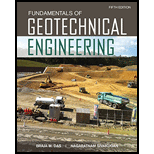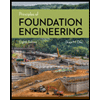
Concept explainers
(a)
Whether the statement “Higher the variability, higher is the coefficient of variation” is true or false.
(a)
Answer to Problem 20.1P
The given statement is
Explanation of Solution
Write the equation of coefficient of variation.
- From Equation (1), the coefficient of variation is directly proportional to the standard deviation.
- The higher variability in data implies higher standard deviation. Hence, the higher standard deviation gives a higher percentage of coefficient of variation.
Therefore, the statement is
(b)
Whether the statement “Coefficient of variation cannot exceed 100%” is true or false.
(b)
Answer to Problem 20.1P
The given statement is
Explanation of Solution
From Equation (1):
The coefficient of variation exceeds 100% when the standard deviation is more than the mean. Hence, the coefficient of variation exceeds 100% is possible.
Therefore, the given statement is
(c)
Whether the statement “The loads used in LRFD are greater than those used in ASD” is true or false.
(c)
Answer to Problem 20.1P
The given statement is
Explanation of Solution
- The allowable strength of the member or component is less than the full strength of member or component.
- In LRFD method, the loads are compared to the full strength of the member; whereas in ASD method, the loads are compared to the allowable strength of the member. Hence, the loads in LRFD method are usually greater than the ASD method.
Therefore, the given statement is
(d)
Whether the statement “The load/resistance factors used for foundations are different from retaining walls” is true or false.
(d)
Answer to Problem 20.1P
The given statement is
Explanation of Solution
- The method for design of foundation is LRFD; while for retain wall, the standard method is used to design.
- Hence, the load/resistance factors for foundations and retaining walls are different.
Therefore, the statement is
(e)
Whether the statement “The load factors in LRFD are generally greater than 1” is true or false.
(e)
Answer to Problem 20.1P
The given statement is
Explanation of Solution
- LRFD design method follows limit state of design approach, where no separate factor of safety is used.
- In the limit state design approach, generally, the loads and resistance factors are already adjusted by partial safety factors. In this design method, ultimate loads are compared to actual loads.
- Hence, the load factors are greater than 1 and resistance factors are less than 1.
Therefore, the given statement is
Want to see more full solutions like this?
Chapter 20 Solutions
Fundamentals of Geotechnical Engineering (MindTap Course List)
- For the drilled shaft described in Problem 19.7, estimate the total elastic settlement at working load. Use Eqs. (18.45), (18.47), and (18.48). Assume that Ep = 20 106 kN/m2, s = 0.3, Es = 12 103 kN/m2, = 0.65 and Cp = 0.03. Assume 80% mobilization of skin resistance at working load. (See Part c of Problem 19.7) 19.7 Figure 19.16 shows a drilled shaft without a bell. Here, L1 = 6 m, L2 = 7 m, Ds = 1.5 m, cu(1) = 50 kN/m2, and cu(2) = 75 kN/m2. Find these values: a. The net ultimate point bearing capacity. Use Eqs. (19.23) and (19.24) b. The ultimate skin resistance. Use Eqs. (19.26) and (19.28) c. The working load, Qw (FS = 3) FIG. 19.16arrow_forwardFor the drilled shaft described in Problem 19.7, determine these values: a. The ultimate load-carrying capacity b. The load-carrying capacity for a settlement of 25 mm Use the procedure outlined in Section 19.8. 19.7 Figure 19.16 shows a drilled shaft without a bell. Here, L1 = 6 m, L2 = 7 m, Ds = 1.5 m, cu(1) = 50 kN/m2, and cu(2) = 75 kN/m2. Find these values: a. The net ultimate point bearing capacity. Use Eqs. (19.23) and (19.24) b. The ultimate skin resistance. Use Eqs. (19.26) and (19.28) c. The working load, Qw (FS = 3) FIG. 19.16arrow_forwardIn Problem 18.4, find the maximum bending moment in the sheet pile and determine the required section modulus, assuming an allowable stress of 190 MN/m2. 18.4 Refer to Figure 18.13. Given L1 = 1.5 m, L2 = 3 m; for the sand, =33, =16.5kN/m3, sat=19.0kN/m3; and, for the clay, c=50kN/m2, =0, sat=20kN/m3. Determine the depth of sheet pile required, allowing for a 50% increase from the theoretical estimate.arrow_forward
- Refer to Figure 18.26b. Let L = 15.24 m, fill = 17.29 kN/m3, sat(clay) = 19.49 kN/m3, clay = 20, Hf = 3.05 m, and D = 0.406 m. The water table coincides with the top of the clay layer. Determine the total downward drag on the pile. Assume that = 0.6 clay. FIG. 18.26 Negative skin frictionarrow_forward(a) A pit of 6.4 m deep is to be excavated in a fine sand stratum completely saturated up to the ground surface. The saturated unit weight of the sand was obtained as 20.3 kN/m3. To stabilize the bottom of the excavation (pr o stabilize the bottom of the excavation (prevent boiling), it was decided to drive steel sheet piles to act as cutoff walls that encircle the excavation. decided to drive steel sheet piles to act as cutoff walls that encircle the excavation. Determine the total length of sheet pile wall to provide a factor of safety of 1.5 against sand boiling. Assume specific gravity of soil, against sand boiling. Assume specific gravity of soil, Gs= 2.7 and unit weight of water, γw = 9.81 kN/m3arrow_forwardRefer to Figure 9.42b. Let L = 18 m, γfill = 17 kN/m3, γsat(clay) = 19.8 kN/m3, Φ'clay = 20°, Hf = 3.5 m, and D (pile diameter) = 406 mm. The water table coincides with the top of the clay layer. Determine the total downward drag force on the pile. Assume ẟ' = 0.6 Φ'clay.arrow_forward
 Fundamentals of Geotechnical Engineering (MindTap...Civil EngineeringISBN:9781305635180Author:Braja M. Das, Nagaratnam SivakuganPublisher:Cengage Learning
Fundamentals of Geotechnical Engineering (MindTap...Civil EngineeringISBN:9781305635180Author:Braja M. Das, Nagaratnam SivakuganPublisher:Cengage Learning Principles of Foundation Engineering (MindTap Cou...Civil EngineeringISBN:9781305081550Author:Braja M. DasPublisher:Cengage Learning
Principles of Foundation Engineering (MindTap Cou...Civil EngineeringISBN:9781305081550Author:Braja M. DasPublisher:Cengage Learning Principles of Foundation Engineering (MindTap Cou...Civil EngineeringISBN:9781337705028Author:Braja M. Das, Nagaratnam SivakuganPublisher:Cengage Learning
Principles of Foundation Engineering (MindTap Cou...Civil EngineeringISBN:9781337705028Author:Braja M. Das, Nagaratnam SivakuganPublisher:Cengage Learning


